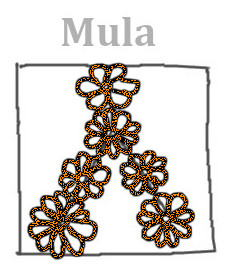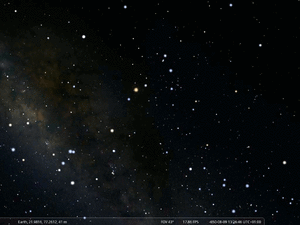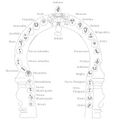Mula: Difference between revisions
No edit summary |
No edit summary |
||
| (5 intermediate revisions by the same user not shown) | |||
| Line 1: | Line 1: | ||
{{DISPLAYTITLE:}} |
{{DISPLAYTITLE:Mūlā (मूल)}} |
||
[[File:Mula nakshatras in Temple draw+lbl 4ase.jpg|thumb|Mula, 19th nakshatra, in Tirupperunthurai (Athmanathaswamy temple) near Aranthangi, India, 10th century CE. (SMH 2025).]] |
|||
[[File:17-19 nakshatra stellarium.gif|thumb|The 17th, 18th, 19th nakshatra mapped to the Stellarium base chart, animated GIF, WGSN 2025. Mula is the left (easternmost) of them. ]] |
|||
Mūlā (मूल), The Root, is an Indian name, used by the Indian Vedic tradition. Most of these names are roughly 3000 years old. They pre-date Hinduism but were taken over by it. Perhaps identified with ε, μ, ζ, η, θ, ι, κ, and λ Scorpii. |
|||
==Etymology and History== |
==Etymology and History== |
||
'''Name Variants''' |
|||
It brightest part of the Milky Way Galaxy, today known as "Galactic Bulge" appears visually like a tuber from which new plants are born. This might be the cause for the name of this constellation and section of the ecliptic. |
|||
* Mula, |
|||
* Nirtibha |
|||
[[File:Milky Way 24mm.jpg|thumb|Milky Way center (CC BY Martin Bernardi)]] |
|||
Its brightest part of the Milky Way Galaxy, today known as "Galactic Bulge" appears visually like a tuber from which new plants are born. This might be the cause for the name of this constellation and section of the ecliptic. |
|||
The symbol of Mula is a bunch of roots tied together (reticulated roots) or an 'elephant goad'. |
The symbol of Mula is a bunch of roots tied together (reticulated roots) or an 'elephant goad'. |
||
=== Origin of Constellation === |
=== Origin of Constellation === |
||
The temple depiction of the nakshatra asterism shows eleven stars surrounding a longish structure that broadens towards the right end. The stars are typically identified with the group of the tail of Scorpius which has plenty of stars. The eight stars ε, μ, ζ, η, θ, ι, κ, and λ Scorpii are certainly part of it, for the additional three, it could be υ Sco, Q Sco and G Sco. Yet, in historical star catalogues, υ and λ Sco are sometimes counted as a double star, which would allow for adding the open star cluster M7 ("Ptolemy's Cluster") as a "fuzzy star": all this is uncertain; we only know that the 11 stars surrounded the area of dark clouds in the Milky Way which may suggest that "the root" itself was considered a dark constellation or consisted of such (e.g. the earth in which the root is placed). |
|||
====Stars within the Constellation Area==== |
|||
{| class="wikitable sortable mw-collapsible" |
|||
|+ |
|||
|- |
|||
!id |
|||
!Label |
|||
!IAU design. |
|||
!description |
|||
!Vmag |
|||
|- |
|||
|1 |
|||
|Shaula |
|||
|HIP 85927 |
|||
|Constellation lines (Vertex) |
|||
|1.63 |
|||
|- |
|||
|2 |
|||
|κ Scorpii |
|||
|HIP 86670 |
|||
|Inside the hull |
|||
|2.386 |
|||
|- |
|||
| 3 |
|||
|Lesath |
|||
|HIP 85696 |
|||
| Constellation lines (Vertex) |
|||
|2.65 |
|||
|- |
|||
| 4 |
|||
|ι 1 Scorpii |
|||
| HIP 87073 |
|||
|Constellation lines |
|||
|2.992 |
|||
|- |
|||
|5 |
|||
|Fuyue |
|||
|HIP 87261 |
|||
| Constellation lines |
|||
|3.21 |
|||
|- |
|||
|6 |
|||
|Q Sco |
|||
|HIP 86170 |
|||
|Constellation lines (Vertex) |
|||
|4.267 |
|||
|- |
|||
|7 |
|||
|ι 2 Scorpii |
|||
|HIP 87294 |
|||
|Inside the hull |
|||
|4.803 |
|||
|- |
|||
| 8 |
|||
| - |
|||
|HIP 86698 |
|||
| Constellation lines (Vertex) |
|||
| 5.52 |
|||
|- |
|||
|9 |
|||
|12 G. Sgr |
|||
|HIP 88038 |
|||
|Constellation lines (Vertex) |
|||
| 5.737 |
|||
|- |
|||
|10 |
|||
| - |
|||
|HIP 87390 |
|||
|Constellation lines (Vertex) |
|||
| 5.958 |
|||
|- |
|||
|11 |
|||
| - |
|||
|HIP 86246 |
|||
|Inside the hull |
|||
|6.27 |
|||
|- |
|||
|12 |
|||
|[SC96] Mis 549 |
|||
|[SC96] Mis 549 |
|||
|Inside the hull |
|||
|6.32 |
|||
|- |
|||
|13 |
|||
| - |
|||
|HIP 87042 |
|||
|Inside the hull |
|||
|6.4 |
|||
|- |
|||
|14 |
|||
| - |
|||
| HIP 86098 |
|||
|Inside the hull |
|||
|6.463 |
|||
|} |
|||
=== Transfer and Transformation of the Constellation === |
=== Transfer and Transformation of the Constellation === |
||
<gallery> |
|||
File:Mula nakshatras in Temple draw+lbl 4ase.jpg|Mula, 10th century CE |
|||
File:Nakshatra temple magDraw lbl.jpg|Display of all 28th nakshatras in silver arch with candles in Tirupperunthurai (Athmanathaswamy temple) near Aranthangi, India, 10th century CE. (SMH 2025). |
|||
File:Nakshatras in Temple draw+lbl 4ase.jpg|Display of all 28th nakshatras in a door frame in Tirupperunthurai (Athmanathaswamy temple) near Aranthangi, India, 10th century CE. (SMH 2025). |
|||
File:Tibet nakshatra 17.png|Mula, Tibetean |
|||
File:尾宿(仏像図彙).png|Mula, Chinese |
|||
File:19 Mula draw.png|Mula as reconstructed by Jones (1720). |
|||
</gallery> |
|||
== Mythology == |
== Mythology == |
||
Latest revision as of 17:22, 14 December 2025
Mūlā (मूल), The Root, is an Indian name, used by the Indian Vedic tradition. Most of these names are roughly 3000 years old. They pre-date Hinduism but were taken over by it. Perhaps identified with ε, μ, ζ, η, θ, ι, κ, and λ Scorpii.
Etymology and History
Name Variants
- Mula,
- Nirtibha
Its brightest part of the Milky Way Galaxy, today known as "Galactic Bulge" appears visually like a tuber from which new plants are born. This might be the cause for the name of this constellation and section of the ecliptic.
The symbol of Mula is a bunch of roots tied together (reticulated roots) or an 'elephant goad'.
Origin of Constellation
The temple depiction of the nakshatra asterism shows eleven stars surrounding a longish structure that broadens towards the right end. The stars are typically identified with the group of the tail of Scorpius which has plenty of stars. The eight stars ε, μ, ζ, η, θ, ι, κ, and λ Scorpii are certainly part of it, for the additional three, it could be υ Sco, Q Sco and G Sco. Yet, in historical star catalogues, υ and λ Sco are sometimes counted as a double star, which would allow for adding the open star cluster M7 ("Ptolemy's Cluster") as a "fuzzy star": all this is uncertain; we only know that the 11 stars surrounded the area of dark clouds in the Milky Way which may suggest that "the root" itself was considered a dark constellation or consisted of such (e.g. the earth in which the root is placed).
Stars within the Constellation Area
| id | Label | IAU design. | description | Vmag |
|---|---|---|---|---|
| 1 | Shaula | HIP 85927 | Constellation lines (Vertex) | 1.63 |
| 2 | κ Scorpii | HIP 86670 | Inside the hull | 2.386 |
| 3 | Lesath | HIP 85696 | Constellation lines (Vertex) | 2.65 |
| 4 | ι 1 Scorpii | HIP 87073 | Constellation lines | 2.992 |
| 5 | Fuyue | HIP 87261 | Constellation lines | 3.21 |
| 6 | Q Sco | HIP 86170 | Constellation lines (Vertex) | 4.267 |
| 7 | ι 2 Scorpii | HIP 87294 | Inside the hull | 4.803 |
| 8 | - | HIP 86698 | Constellation lines (Vertex) | 5.52 |
| 9 | 12 G. Sgr | HIP 88038 | Constellation lines (Vertex) | 5.737 |
| 10 | - | HIP 87390 | Constellation lines (Vertex) | 5.958 |
| 11 | - | HIP 86246 | Inside the hull | 6.27 |
| 12 | [SC96] Mis 549 | [SC96] Mis 549 | Inside the hull | 6.32 |
| 13 | - | HIP 87042 | Inside the hull | 6.4 |
| 14 | - | HIP 86098 | Inside the hull | 6.463 |
Transfer and Transformation of the Constellation
Mythology
mnemonic tales and cultural significance
Weblinks
References
- References (general)












